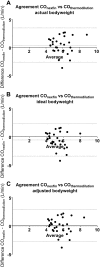Pulse-contour derived cardiac output measurements in morbid obesity: influence of actual, ideal and adjusted bodyweight
- PMID: 28822023
- PMCID: PMC5943384
- DOI: 10.1007/s10877-017-0053-8
Pulse-contour derived cardiac output measurements in morbid obesity: influence of actual, ideal and adjusted bodyweight
Abstract
The non-invasive Nexfin cardiac output (CO) monitor shows a low level of agreement with the gold standard thermodilution method in morbidly obese patients. Here we investigate whether this disagreement is related to excessive bodyweight, and can be improved when bodyweight derivatives are used instead. We performed offline analyses of cardiac output recordings of patient data previously used and partly published in an earlier study by our group. In 30 morbidly obese patients (BMI > 35 kg/m2) undergoing laparoscopic gastric bypass, cardiac output was simultaneously determined with PiCCO thermodilution and Nexfin pulse-contour method. We investigated if agreement of Nexfin-derived CO with thermodilution CO improved when ideal and adjusted-instead of actual- bodyweight were used as input to the Nexfin. Bodyweight correlated with the difference between Nexfin-derived and thermodilution-derived CO (r = -0.56; p = 0.001). Bland Altman analysis of agreement between Nexfin and thermodilution-derived CO revealed a bias of 0.4 ± 1.6 with limits of agreement (LOA) from -2.6 to 3.5 L min when actual bodyweight was used. Bias was -0.6 ± 1.4 and LOA ranged from -3.4 to 2.3 L min when ideal bodyweight was used. With adjusted bodyweight, bias improved to 0.04 ± 1.4 with LOA from -2.8 to 2.9 L min. Our study shows that agreement of the Nexfin-derived with invasive CO measurements in morbidly obese patients is influenced by body weight, suggesting that Nexfin CO measurements in patients with a BMI above 35 kg/m2 should be interpreted with caution. Using adjusted body weight in the Nexfin CO-trek algorithm reduced the bias.
Keywords: Bodyweight; Cardiac output; Obesity; Pulse contour.
Conflict of interest statement
Conflict of interest
The authors declare that they have no conflict of interest.
Ethical approval
All procedures performed in studies involving human participants were in accordance with the ethical standards of the institutional research committee and with the 1964 Helsinki declaration and its later amendments or comparable ethical standards.
Informed consent
Informed consent was obtained from all individual participants in the study.
Figures


Similar articles
-
Level of agreement between cardiac output measurements using Nexfin® and thermodilution in morbidly obese patients undergoing laparoscopic surgery.Anaesthesia. 2016 Dec;71(12):1449-1455. doi: 10.1111/anae.13627. Epub 2016 Sep 26. Anaesthesia. 2016. PMID: 27667644
-
Cardiac output measurement by bioimpedance and noninvasive pulse contour analysis compared with the continuous pulmonary artery thermodilution technique.J Cardiothorac Vasc Anesth. 2014 Jun;28(3):534-9. doi: 10.1053/j.jvca.2014.01.007. Epub 2014 Apr 16. J Cardiothorac Vasc Anesth. 2014. PMID: 24746334
-
A comparison of the Nexfin® and transcardiopulmonary thermodilution to estimate cardiac output during coronary artery surgery.Anaesthesia. 2012 Apr;67(4):377-83. doi: 10.1111/j.1365-2044.2011.07018.x. Epub 2012 Feb 11. Anaesthesia. 2012. PMID: 22324797
-
Performance of a minimally invasive uncalibrated cardiac output monitoring system (Flotrac/Vigileo) in haemodynamically unstable patients.Br J Anaesth. 2008 Apr;100(4):451-6. doi: 10.1093/bja/aem409. Epub 2008 Feb 6. Br J Anaesth. 2008. PMID: 18256056 Review.
-
Cardiac output monitoring.Ann Card Anaesth. 2008 Jan-Jun;11(1):56-68. doi: 10.4103/0971-9784.38455. Ann Card Anaesth. 2008. PMID: 18182765 Review.
Cited by
-
Journal of clinical monitoring and computing end of year summary 2018: hemodynamic monitoring and management.J Clin Monit Comput. 2019 Apr;33(2):211-222. doi: 10.1007/s10877-019-00297-w. Epub 2019 Mar 7. J Clin Monit Comput. 2019. PMID: 30847738 Free PMC article. Review.
-
Intraoperative Monitoring of the Obese Patient Undergoing Surgery: A Narrative Review.Adv Ther. 2021 Jul;38(7):3622-3651. doi: 10.1007/s12325-021-01774-y. Epub 2021 Jun 5. Adv Ther. 2021. PMID: 34091873 Free PMC article. Review.
-
Accuracy and trending ability of finger plethysmographic cardiac output monitoring in late pregnancy.Can J Anaesth. 2022 Nov;69(11):1340-1348. doi: 10.1007/s12630-022-02297-y. Epub 2022 Aug 4. Can J Anaesth. 2022. PMID: 35927539 English.
-
Perioperative non-invasive versus semi-invasive cardiac index monitoring in patients with bariatric surgery - a prospective observational study.BMC Anesthesiol. 2020 Aug 10;20(1):196. doi: 10.1186/s12871-020-01110-x. BMC Anesthesiol. 2020. PMID: 32778047 Free PMC article. Clinical Trial.
References
-
- Kheterpal S, O’Reilly M, Englesbe MJ, Rosenberg AL, Shanks AM, Zhang L, Rothman ED, Campbell DA, Tremper KK. Preoperative and intraoperative predictors of cardiac adverse events after general, vascular, and urological surgery. Anesthesiology. 2009;110:58–66. doi: 10.1097/ALN.0b013e318190b6dc. - DOI - PubMed
-
- Bogert LW, Wesseling KH, Schraa O, van Lieshout EJ, de Mol BA, van Goudoever J, Westerhof BE, van Lieshout JJ. Pulse contour cardiac output derived from non-invasive arterial pressure in cardiovascular disease. Anaesthesia. 2010;65(11):1119–1125. doi: 10.1111/j.1365-2044.2010.06511.x. - DOI - PubMed
-
- Broch O, Renner J, Gruenewald M, Meybohm P, Schottler J, Caliebe A, Steinfath M, Malbrain M, Bein B. A comparison of the Nexfin and transcardiopulmonary thermodilution to estimate cardiac output during coronary artery surgery. Anaesthesia. 2012;67(4):377–383. doi: 10.1111/j.1365-2044.2011.07018.x. - DOI - PubMed
MeSH terms
LinkOut - more resources
Full Text Sources
Other Literature Sources
Medical

